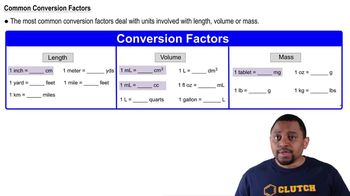How many moles of each substance are needed to prepare the following solutions?
a. 50.0 mL of 8.0% (m/v) KCl (MW = 74.55 g/mol)
b. 200.0 mL of 7.5% (m/v) acetic acid (MW = 60.05 g/mol)
 Verified step by step guidance
Verified step by step guidance Verified video answer for a similar problem:
Verified video answer for a similar problem:



 0:52m
0:52mMaster Percent Concentrations Concept 1 with a bite sized video explanation from Jules
Start learning